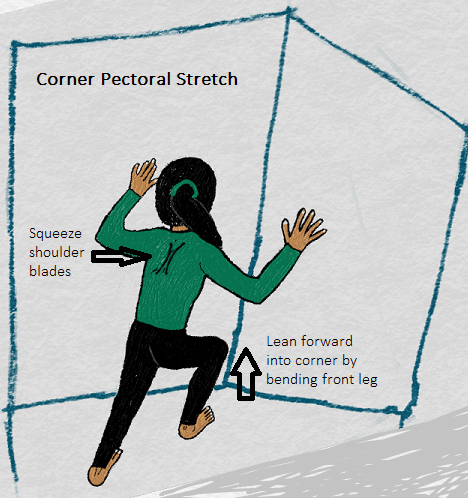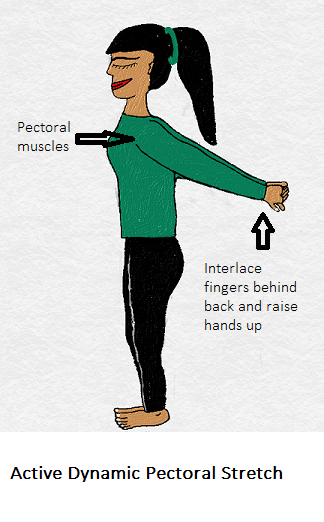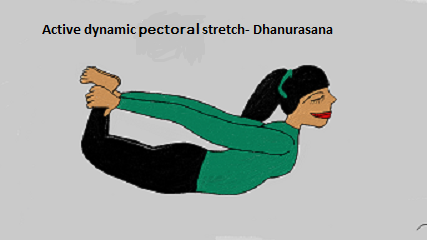|
One of the large muscles that fans over the chest is the pectoralis major. The other muscles in the pectoral region are the pectoralis minor, serratus anterior, and subclavius. The pectoralis minor lies under the pectoralis major.
The pectoralis major originates from the sternum, 1st -6th costal cartilages, the aponeurosis of the external oblique muscle, the medial half of the anterior surface of the clavicle. It inserts into the bicipital groove of the humerus. The pectoralis minor originates from the 3rd to 5th ribs and inserts into the coracoid process of the scapula. Whereas the pectoralis major moves the shoulder into adduction and turns the arm inwards, the pectoralis minor facilitates movement by pulling the scapula anterio-inferiorly into the thoracic wall. Both these muscles are tonic muscles and are prone to tightness and shortening. While the anterior torso stretches are applicable to stretch the pectorals, let us go through some specific and targeted stretches for the pectorals. Passive Stretch This is done in the seated position with the therapist encircling the shoulders from the back and gently elevating and retracting the shoulder blades. This opens the chest and the stretch position is held for 5-30 seconds and released with a 15-30 second rest between stretches. Active Stretch Active Static Stretch: i) This is done while standing and facing the corner in a room. Place both hands, palms facing on each of the two walls at shoulder height. Assume a stride position with the front foot about a foot away from the corner, and engage the transverse abdominus to stabilize the spine in neutral position. The leg forming the back stride leg is kept straight at the knee. Push the palms into the wall engaging the serratus anterior. Slowly move forward over the front ankle joint to lean the trunk into the corner while the chest area opens up and shoulder blades are squeezed together. Hold stretch for 5-30 seconds and release, with 15-30 second rest in between stretches. Active Dynamic Stretch: i) This may be done in the standing position or seated on a stool without a back rest. Assume a good seated posture with feet flat on the floor and a neutral, upright spine. Extend both arms at shoulders behind the back, and interlace the fingers behind the base of spine and slowly raise the hands up and away from the back, while squeezing the shoulder blades and opening the chest/shoulder region. Hold the stretch for 5-30 seconds and release, with a 15-30 second rest in between stretches. ii) Dhanurasana or the bow pose: This is done in prone position, lying on the stomach with arms by the side of trunk, palms facing upwards. Bend both the knees bringing the heels of feet to ischial tuberosities or sit bones and hold the feet around the ankles with your hands. As you inhale, lift the heels away from the ischial tuberosities and lift the thigh off the floor as the torso lifts up. Squeeze the shoulder blades by rotating the shoulder out and pulling them back, hence opening the chest/shoulder region. Ensure both knees are no more than hip width apart. Hold for 2-3 breath cycles and release by first lowering the thighs and torso while bending the knees. Lastly release the hand-hold around the ankles and extend knees. Stretching the pectorals with tools and equipment i) Foam Roll Stretch: This may be done on the bare floor or on exercise mat on the floor. Place the foam roll (at least 36 inches or longer) lengthwise along the mat. The spine is supported on the foam roll with the face up and feet on the floor as in hook-lying position. The occipital protruberance (back of head) and the spine to the sacrum should be supported on the roll while the Transverse Abdominus is engaged for neutral spine. It is important to not arch the back and maintain the gentle anatomical curves. Bending the arms at the elbows, bring the dorsum of hands onto the mat on either side of the torso. Rotate shoulders outwards and supinate the forearms with 90° of elbow flexion, and slowly slide the dorsum of hands in an upward arc towards the head maintaining the contact of the hands with the floor at all times. This opens the chest and shoulder region, stretching the pectoral muscles. Hold for as long as possible between 5-30 seconds as far up as you reach with the hands and slide the arms back to release the stretch. Rest for 15-30 seconds in between stretches.
0 Comments
Your comment will be posted after it is approved.
Leave a Reply. |
Details
AuthorAmi Gandhi is a licensed physical therapist in the state of California. She is the owner of StableMovement Physical Therapy, a small boutique practice in San Jose that offers patient centered, one-on-one, hands-on physical therapy. Archives
March 2018
Categories |


